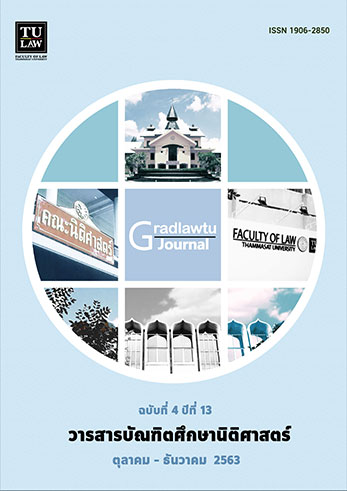การปฏิรูปกฎหมายว่าด้วยการส่งเสริมและพัฒนาคุณภาพชีวิตคนพิการ
Main Article Content
บทคัดย่อ
เมื่อปี พ.ศ. 2524 สหประชาชาติได้ประกาศให้เป็นปีคนพิการสากล ได้มีการเรียกร้องให้รัฐบาลต่าง ๆ ออกกฎหมายว่าด้วยการฟื้นฟูสมรรถภาพคนพิการ รัฐบาลสมัยนั้นมีพลเอก เปรม ติณสูลานนท์ เป็นนายกรัฐมนตรีได้ประกาศนโยบายให้มี พ.ร.บ.ฟื้นฟูสมรรถภาพคนพิการสำหรับประเทศไทย แต่รัฐบาลสิ้นสุดลงก่อนที่กฎหมายจะสำเร็จ เครือข่ายคนพิการโดยการนำของสมาคมสภาคนพิการทุกประเภทแห่งประเทศไทยรณรงค์ให้ได้ พ.ร.บ.ฟื้นฟูสมรรถภาพคนพิการสำเร็จในปี พ.ศ. 2534 ต่อมาสหประชาชาติได้เสนอให้มีอนุสัญญาว่าด้วยสิทธิคนพิการ ซึ่งเน้นหลักการฐานสิทธิให้คนพิการมีสิทธิเสมอภาคเท่าเทียมกับบุคคลทั่วไป ประเทศไทยใช้เวลาพัฒนา พ.ร.บ.ส่งเสริมและพัฒนาคุณภาพชีวิตคนพิการคู่ขนานไปกับอนุสัญญาว่าด้วยสิทธิคนพิการ ในที่สุด พ.ร.บ.ฟื้นฟูสมรรถภาพคนพิการ พ.ศ. 2534 ถูกยกเลิกเปลี่ยนเป็น พ.ร.บ.ส่งเสริมและพัฒนาคุณภาพชีวิตคนพิการ พ.ศ. 2550 กฎหมายทั้ง 2 ฉบับ ให้ความสำคัญในการจัดตั้งกองทุนและให้กองทุนเป็นนิติบุคคล แต่กองทุนก็ยังไม่สามารถเป็นนิติบุคคลได้จนทุกวันนี้ เมื่อมีแผนการปฏิรูปประเทศด้านสังคม ตาม พ.ร.บ.แผนและขั้นตอนการดำเนินการปฏิรูปประเทศ พ.ศ. 2560 จึงได้เสนอเรื่องการปฏิรูปกองทุนเข้าไปในแผนดังกล่าว
การฟื้นฟูสมรรถภาพและการพัฒนาคุณภาพชีวิตคนพิการให้มีสิทธิเท่าเทียมกับบุคคลทั่วไป มีความจำเป็นต้องใช้งบประมาณเป็นจำนวนมาก เพียงแต่อาศัยงบประมาณจากรัฐบาลซึ่งเป็นประเทศกำลังพัฒนาย่อมจะมีไม่เพียงพอ ดังนั้นใน พ.ร.บ.ฟื้นฟูสมรรถภาพคนพิการ พ.ศ. 2534 และพ.ร.บ.ส่งเสริมและพัฒนาคุณภาพชีวิตคนพิการ พ.ศ. 2550 ล้วนแต่กำหนดให้มีการจัดตั้งกองทุน และคนพิการได้ขอให้ร่างกฎหมายกำหนดให้กองทุนส่งเสริมและพัฒนาคุณภาพชีวิตคนพิการเป็นนิติบุคคล หากกองทุนเป็นนิติบุคคลและศูนย์บริการคนพิการทั่วไปมีวัตถุประสงค์ชัดเจนที่จะฟื้นฟูสมรรถภาพคนพิการเพื่อให้ช่วยเหลือตนเองได้ในการดำเนินชีวิตประจำวัน ให้คนพิการได้รับการอบรมเรื่องการประกอบอาชีพ และสนับสนุนให้นำเอาอาชีพที่ได้รับการอบรมไปสร้างรายได้ให้แก่ตนเองและครอบครัว ศูนย์บริการคนพิการทั่วไปที่ยังมีอยู่ในจำนวนไม่มากได้รับการสนับสนุนให้มีการจัดตั้งทั่วประเทศเพื่อให้บริการฝึกอาชีพและสร้างรายได้ให้กับคนพิการทั้งประเทศได้อย่างทั่วถึง โดยวางแผนตามแผนปฏิรูปประเทศไทย 20 ปี ให้คนพิการมีงานทำเพิ่มขึ้นเป็นร้อยละ 80 หรือเป็นจำนวน 680,216 คนของคนพิการที่อยู่ในวัยทำงาน จากปัจจุบันที่คนพิการในวัยทำงานมีงานทำเพียง 265,918 คน นอกจากจะเปลี่ยนคนพิการจากการเป็นภาระของครอบครัวและสังคมให้กลายเป็นพลัง ทำให้คนพิการมีส่วนขับเคลื่อนในการกระตุ้นเศรษฐกิจจากการใช้จ่ายรายได้ของตนที่ได้มาจากการประกอบอาชีพ ดังนั้น การพัฒนาคนพิการให้มีรายได้ มีแต่ได้ไม่มีเสีย ภาครัฐ ภาคเอกชนและคนพิการจึงต้องระดมสัพพะกำลังมาช่วยกันทำงานเพื่อให้แผนที่วางไว้บรรลุผล อันจะก่อให้เกิดประโยชน์แก่คนพิการ ครอบครัวของคนพิการและประเทศไทย
Article Details
บทความหรือข้อความคิดเห็นใด ๆ ที่ปรากฏในวารสารบัณฑิตศึกษานิติศาสตร์เป็นวรรณกรรมของผู้เขียนโดยเฉพาะคณะนิติศาสตร์ มหาวิทยาลัยธรรมศาสตร์ และบรรณาธิการไม่จำเป็นต้องเห็นด้วย


